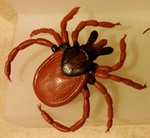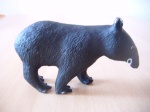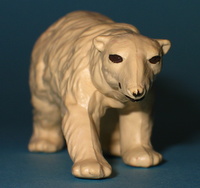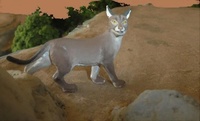|
| | Mathison Museum of Natural History |  |
|
+12landrover Kikimalou bmathison1972 Taos widukind Jill Duck-Anch-Amun lucky luke Caracal rogerpgvg Roger Bloodrayne 16 posters | |
| Author | Message |
|---|
bmathison1972

Country/State : Salt Lake City, UT
Age : 52
Joined : 2010-04-12
Posts : 6719
 |  Subject: Re: Mathison Museum of Natural History Subject: Re: Mathison Museum of Natural History  Thu 01 Feb 2024, 00:35 Thu 01 Feb 2024, 00:35 | |
| Species: Papilio troilus Linnaeus, 1758 Common name(s): spicebush swallowtail About the Figure: Manufacturer: Toys Spirits Series: Caterpillar Mascot Vol. 2 Year of Production: 2020 Size/Scale: Body length 4.8 cm for a scale of 1.1:1 for a maximum-sized mature larva; could easily fit into 1:1 scale Frequency of species in toy/figure form (at time of posting): Unique Miscellaneous Notes: Figures in Toys Spirits' Caterpillar Mascot sets are somewhat stylized and soft and 'squishy'. They are not something I would normally collect, even at the time I got them, but the set included two unique species, including today's. About the Animal: Geographic distribution: Eastern North America Habitat: Deciduous woodlands, pine barrens, wooded swamps, fields, roadsides, parks, gardens Diet: Larvae feed on a variety of plants, including Lindera (spicebush), Cinnamomum (camphor), Sassafras (sassafras), Litsea (pondspice), Persea (bays), and Magnolia (magnolias); adults take nectar from a wide variey of flowers. IUCN Status (at time of posting): Not Evaluated [NatureServe status is Secure] Miscellaneous Notes: Papilio troilus lays eggs 1-2 at a time on an appropriate host plant. Young larvae chew through the leaf from the edge to the midrib, about 19 mm from the tip of the leaf. The larva lies on the midrib and produces silk. Upon drying, the silk contracts and causes the leaf to fold up around the larva to form a shelter. The larvae stay in these shelters during the day, coming out at night to feed. [You must be registered and logged in to see this image.] |
|   | | widukind

Country/State : Germany
Age : 48
Joined : 2010-12-30
Posts : 45779
 |  Subject: Re: Mathison Museum of Natural History Subject: Re: Mathison Museum of Natural History  Thu 01 Feb 2024, 06:34 Thu 01 Feb 2024, 06:34 | |
| It looks like for a swimming pool. But a unique figure |
|   | | Jill

Country/State : USA
Age : 39
Joined : 2021-04-12
Posts : 2350
 |  Subject: Re: Mathison Museum of Natural History Subject: Re: Mathison Museum of Natural History  Thu 01 Feb 2024, 12:03 Thu 01 Feb 2024, 12:03 | |
| I had no idea silk worms were considered domesticated. I didn't know there were any domestic invertebrates, except maybe feeder crickets. Learning new stuff all the time! |
|   | | bmathison1972

Country/State : Salt Lake City, UT
Age : 52
Joined : 2010-04-12
Posts : 6719
 |  Subject: Re: Mathison Museum of Natural History Subject: Re: Mathison Museum of Natural History  Fri 02 Feb 2024, 00:40 Fri 02 Feb 2024, 00:40 | |
| Species: Geothelphusa dehaani (White, 1847) Common name(s): Japanese freshwater crab About the Figure: Manufacturer: Kaiyodo Series: Choco Q Animatales Series 9 Year of Production: 2004 Size/Scale: Carapace width approximately 2.0 cm, within scale 1:1 Frequency of species in toy/figure form (at time of posting): Uncommon Miscellaneous Notes: This is the second time we've seen Geothelphusa dehaani in the Museum. These three figures represent the same sculpt. Being original Choco Q Animatales figures, some assembly is required. If I remember correctly, the white version was a secret/chase figure. About the Animal: Geographic distribution: Japan Habitat: Montane forests, usually in riparian areas including clear streams and surrounding terrestrial habitats (under rocks and logs, in forest litter, etc.) Diet: General omnivore; primarily terrestrial and aquatic invertebrates and carrion, but occasionally plant material and detritus. Cannibalism not uncommon. IUCN Status (at time of posting): Least Concern Miscellaneous Notes: Geothelphusa dehaani exhibits extreme color variation throughout its range, although in a given area only one or a couple color morphs may be present. Researchers have classified the various colors using two-letter codes, including DA (dark), BL (blue), RE (red), TC (two-toned), PB (purple-brown), and GP (green-brown), for example. Some of these colors have subgroups (e.g. BL1, BL2) and some considered 'contaminated' (sharing colors of more than one morph) are designated as DA', BL', etc. The color variation in G. dehanni is due to intraspecific genetic differentiation and is believed to be due to genetic isolation on different islands, as freshwater crabs are unlikely to cross marine waters. [You must be registered and logged in to see this image.] |
|   | | widukind

Country/State : Germany
Age : 48
Joined : 2010-12-30
Posts : 45779
 |  Subject: Re: Mathison Museum of Natural History Subject: Re: Mathison Museum of Natural History  Fri 02 Feb 2024, 07:22 Fri 02 Feb 2024, 07:22 | |
| |
|   | | bmathison1972

Country/State : Salt Lake City, UT
Age : 52
Joined : 2010-04-12
Posts : 6719
 |  Subject: Re: Mathison Museum of Natural History Subject: Re: Mathison Museum of Natural History  Sat 03 Feb 2024, 02:05 Sat 03 Feb 2024, 02:05 | |
| Species: Cyclops sp. About the Figure: Manufacturer: Epoch Series: Ecology of Plankton Year of Production: 2004 Size/Scale: Body length (excluding appendages) approximately 2.0 cm for a scale of 40:1-4:1 depending on the species Frequency of species in toy/figure form (at time of posting): Very rare Miscellaneous Notes: The figures in the Ecology of Plankton collection come in little jars suspended in a goo (see inset, minus the goo), as if to simulate biological specimens in a lab. I bought my set from forum member sbell, who had already removed the goo (which I probably would have done as well). The jars measure 3.7 cm tall and are 3.0 cm in diameter. About the Animal: Geographic distribution: Cosmopolitan Habitat: Still and slow-moving freshwater, including lakes, ponds, canals, ditches, neglected swimming pools Diet: Aquatic vegetation, free-living nematodes, carrion IUCN Status (at time of posting): Not Evaluated Miscellaneous Notes: There are over 400 described species of Cyclops. They are an important part of a freshwater ecosystem, serving as food for aquatic insects, fish, amphibians, and reptiles. [You must be registered and logged in to see this image.] |
|   | | bmathison1972

Country/State : Salt Lake City, UT
Age : 52
Joined : 2010-04-12
Posts : 6719
 |  Subject: Re: Mathison Museum of Natural History Subject: Re: Mathison Museum of Natural History  Sun 04 Feb 2024, 02:20 Sun 04 Feb 2024, 02:20 | |
| Species: Temognatha murrayi (Gemminger & Harold, 1869) Common name(s): black-banded jewel beetle About the Figures: Manufacturer: Cadbury Series: Yowies Series 1; Yowies UK Series 1 Year of Production: 1997 Size/Scale: Body length of Australian Yowie approximately 4.7 cm for a scale of 1.6:1-1.2:1. Body length of UK Yowie approximately 3.3 cm, within scale 1:1. Frequency of species in toy/figure form (at time of posting): Very rare (unique as a pair) Miscellaneous Notes: The figure on the upper right is the Australian release; it requires assembly and is more stylized (the head and prothorax appear as one homogenized structure). The figure on the lower left is the UK release; it is a single piece of plastic and the beetle is permanently affixed to its flower base. Both were produced in 1997. Neither figure is a particularly good likeness for the species, but they are a unique pair and buprestid beetles in general are very rarely made. About the Animal: Geographic distribution: Australia (southwestern Western Australia) Habitat: Mallee woodlands and shrublands Diet: Larval host plants unknown (presumably Eucalyptus or Casuarina); adults feed on the flowers of Eucalyptus, especially E. foecunda and E. uncinata. IUCN Status (at time of posting): Not Evaluated Miscellaneous Notes: Like many other buprestid beetles that live in arid and semi-arid environments, T. murrayi tends to be active at the hottest time of the day during the hottest time of the year, making field observations and collection challenging. Their population also fluctuates annually, being present in large numbers in some years, and absent, or apparently so, in others. [You must be registered and logged in to see this image.] |
|   | | widukind

Country/State : Germany
Age : 48
Joined : 2010-12-30
Posts : 45779
 |  Subject: Re: Mathison Museum of Natural History Subject: Re: Mathison Museum of Natural History  Sun 04 Feb 2024, 20:52 Sun 04 Feb 2024, 20:52 | |
| |
|   | | bmathison1972

Country/State : Salt Lake City, UT
Age : 52
Joined : 2010-04-12
Posts : 6719
 |  Subject: Re: Mathison Museum of Natural History Subject: Re: Mathison Museum of Natural History  Mon 05 Feb 2024, 01:58 Mon 05 Feb 2024, 01:58 | |
| Species: Architeuthis dux Steenstrup, 1857 Common name(s): giant squid About the Figure: Manufacturer: Safari Ltd. Series: Wild Safari Sealife Year of Production: 2004 Size/Scale: Total figure length approximately 24.5 cm. Mantle length approximately 5.5 cm for a scale of 1:17.1-1:40.9 Frequency of species in toy/figure form (at time of posting): Uncommon Miscellaneous Notes: This figure is essentially a smaller version of the Monterey Bay Aquarium model that was produced in 1998. About the Animal: Geographic distribution: Worldwide Habitat: Bathypelagic; at depths of 200-1000 meters Diet: Fish, other squid IUCN Status (at time of posting): Least Concern Miscellaneous Notes: At least 19 species of Architeuthis have been described in the scientific literature. Analysis of mitochondrial DNA from specimens from all around the world show little variation and suggests there is only a single species in the genus, A. dux. [You must be registered and logged in to see this image.] |
|   | | widukind

Country/State : Germany
Age : 48
Joined : 2010-12-30
Posts : 45779
 |  Subject: Re: Mathison Museum of Natural History Subject: Re: Mathison Museum of Natural History  Mon 05 Feb 2024, 06:06 Mon 05 Feb 2024, 06:06 | |
| |
|   | | bmathison1972

Country/State : Salt Lake City, UT
Age : 52
Joined : 2010-04-12
Posts : 6719
 |  Subject: Re: Mathison Museum of Natural History Subject: Re: Mathison Museum of Natural History  Tue 06 Feb 2024, 00:44 Tue 06 Feb 2024, 00:44 | |
| Species: Gorilla gorilla gorilla (Savage, 1847) Common name(s): western lowland gorilla About the Figure: Manufacturer: Schleich Series: Wild Life Africa Year of Production: 2017 Size/Scale: Scale difficult to calculate but using body length as a metric (n=6.0 cm) per Breuer et al. (see below) scale comes to approximately 1:14.2-1:16.2. Frequency of species in toy/figure form (at time of posting): Indeterminant (see below) Miscellaneous Notes: At the time I bought this figure, Schleich has specifically marketed it as Gorilla gorilla. I chose it to represent this subspecies because of its familiarity. Because morphologic features separating gorillas are 'soft' and difficult to capture and interpret in a toy or figure, it is often not possible to determine the species or subspecies unless specified by the manufacturer. I found it very difficult to find metrics to calculate scale, as most online references used armspan or height when standing on two legs. The scale above was calculated using the following reference that does not include the head when measuring body length: Breuer T, Robbins MM, Boesch C. Using photogrammetry and color scoring to assess sexual dimorphism in wild western gorillas ( Gorilla gorilla). Am J Physical Anthropology. 2007;134:369-382. About the Animal: Geographic distribution: Equatorial West Africa Habitat: Montane primary and secondary rainforest, lowland swamp forest, riparian areas, forest edges, abandoned agricultural land Diet: Roots, shoots, fruit, foliage, tree bark and pulp; diet varies based on seasonal availability IUCN Status (at time of posting): Critically Endangered Miscellaneous Notes: Gorilla gorilla gorilla lives in some of the smallest family groups among gorilla species and subspecies. A family unit typically consists of a silverback male, about three females, and their offspring. If more than one mature male is present in the group, they usually represent father and son, with the father being the leader. Most males leave their natal group shortly before reaching sexual maturity and do through a 'bachelor stage' that can last several years. In this bachelor state, they are either solitary or live in nonbreeding groups. Gorillas do not keep defined territories and neighboring groups often overlap in their ranges. [You must be registered and logged in to see this image.] |
|   | | rogerpgvg

Country/State : UK
Age : 54
Joined : 2016-04-29
Posts : 3897
 |  Subject: Re: Mathison Museum of Natural History Subject: Re: Mathison Museum of Natural History  Tue 06 Feb 2024, 04:26 Tue 06 Feb 2024, 04:26 | |
| I was recently also looking for information about Gorilla size. Breuer and colleagues have published several articles using the same data. For Western gorillas, I also found:
Caillaud et al. (2008)
Shea et al. (1979)
Their data are consistent with the Breuer et al. data. Caillaud et al. (2008) report only a very slightly wider size range.
Mountain gorillas seem to have a similar size. I found this article quite interesting:
Galbany et al. (2017)
The Schleich looks great! |
|   | | widukind

Country/State : Germany
Age : 48
Joined : 2010-12-30
Posts : 45779
 |  Subject: Re: Mathison Museum of Natural History Subject: Re: Mathison Museum of Natural History  Tue 06 Feb 2024, 05:57 Tue 06 Feb 2024, 05:57 | |
| |
|   | | bmathison1972

Country/State : Salt Lake City, UT
Age : 52
Joined : 2010-04-12
Posts : 6719
 |  Subject: Re: Mathison Museum of Natural History Subject: Re: Mathison Museum of Natural History  Wed 07 Feb 2024, 00:43 Wed 07 Feb 2024, 00:43 | |
| Species: Trigonognathus kabeyai Mochizuki & Ohe, 1990 Common name(s): viper dogfish; viper shark; triangular-jaw lantern-shark About the Figure: Manufacturer: Bandai Series: Diversity of Life on Earth - Mini Sharks Year of Production: 2023 Size/Scale: Body length approximately 8.7 cm for a scale of 1:5.4-1:6.2 Frequency of species in toy/figure form (at time of posting): Unique Miscellaneous Notes: The fish is removable from its base, and the attachment peg is on the base, not the fish. And for the fish enthusiasts, there is a lanternfish prey (see below) on the base. About the Animal: Geographic distribution: Northwest Pacific (Japan) to Hawaii Habitat: Bathydemersal; at depths of 150-360 meters Diet: Fish (especially lanternfish), crustaceans IUCN Status (at time of posting): Least Concern Miscellaneous Notes: Like many deep sea predatory fish, T. kabeyai exhibits vertical migration, living in deeper waters during the day (approx. 270-360 m) and then coming up to shallower waters (approx. 150 m) at night to feed. Vertical migration is also for the safety of the dogfish, keeping in hidden in deeper, darker waters during the day and away from its predators. Predators of T. kabeyai include bigeye tuna ( Thunnus obesus) and the sickle pomfret ( Taractichthys steindachneri). [You must be registered and logged in to see this image.] |
|   | | widukind

Country/State : Germany
Age : 48
Joined : 2010-12-30
Posts : 45779
 |  Subject: Re: Mathison Museum of Natural History Subject: Re: Mathison Museum of Natural History  Wed 07 Feb 2024, 05:46 Wed 07 Feb 2024, 05:46 | |
| |
|   | | Caracal

Country/State : France
Age : 65
Joined : 2018-10-24
Posts : 7261
 | |   | | bmathison1972

Country/State : Salt Lake City, UT
Age : 52
Joined : 2010-04-12
Posts : 6719
 |  Subject: Re: Mathison Museum of Natural History Subject: Re: Mathison Museum of Natural History  Thu 08 Feb 2024, 00:45 Thu 08 Feb 2024, 00:45 | |
| Species: Musca domestica Linnaeus, 1758 Common name(s): house fly About the Figure: Manufacturer: Bullyland Series: Large Insects and Spiders Year of Production: 1994 Size/Scale: Body length (excluding wings and appendages approximately 7.0 cm for a scale of 11.7:1-10:1 Frequency of species in toy/figure form (at time of posting): Rare Miscellaneous Notes: Bullyland released two color versions of this fly; the other on Toy Animal Wiki is classified as 'colored' although I have never seen it to know what color it is. I have also seen, and previously owned for a period of time, a knock-off of this model from a dollar store. Early in my collecting days I found a couple sets of insects in a dollar store that, unbeknownst to me at the time, were mostly Bullyland knock-offs. About the Animal: Geographic distribution: Cosmopolitan Habitat: Highly variable throughout urban and rural areas; a synanthropic species, usually associated with human activity Diet: Larvae feed in carrion, dung, rotting vegetation, detritus, human refuse; adults feed on moist material rich in organic matter, often where larvae are developing IUCN Status (at time of posting): Not Evaluated Miscellaneous Notes: Musca domestica is believed to have originated on the steppes of Central Asia, and now occurs nearly worldwide wherever humans live. [You must be registered and logged in to see this image.] |
|   | | Caracal

Country/State : France
Age : 65
Joined : 2018-10-24
Posts : 7261
 |  Subject: Re: Mathison Museum of Natural History Subject: Re: Mathison Museum of Natural History  Thu 08 Feb 2024, 01:55 Thu 08 Feb 2024, 01:55 | |
| I did not know this Bully fly! Very terrific picture because of distorsion scale!  |
|   | | rogerpgvg

Country/State : UK
Age : 54
Joined : 2016-04-29
Posts : 3897
 |  Subject: Re: Mathison Museum of Natural History Subject: Re: Mathison Museum of Natural History  Thu 08 Feb 2024, 05:51 Thu 08 Feb 2024, 05:51 | |
| Another common species that isn't often made in model form. I like the transparent wings.
I am sorry this monster spoiled your dinner! |
|   | | widukind

Country/State : Germany
Age : 48
Joined : 2010-12-30
Posts : 45779
 |  Subject: Re: Mathison Museum of Natural History Subject: Re: Mathison Museum of Natural History  Thu 08 Feb 2024, 19:10 Thu 08 Feb 2024, 19:10 | |
| |
|   | | bmathison1972

Country/State : Salt Lake City, UT
Age : 52
Joined : 2010-04-12
Posts : 6719
 |  Subject: Re: Mathison Museum of Natural History Subject: Re: Mathison Museum of Natural History  Fri 09 Feb 2024, 00:39 Fri 09 Feb 2024, 00:39 | |
| Species: Remora remora (Linnaeus, 1758) Common name(s): common remora; shark sucker About the Figure: Manufacturer: Takara Tomy A.R.T.S. Series: World of the Blue Sea: The Shark Year of Production: 2023 Size/Scale: Base 4.2 cm wide. Individual fish approximately 2.4 cm for a scale of 1:16.7-1:36 Frequency of species in toy/figure form (at time of posting): Rare Miscellaneous Notes: These three remoras were essentially accessories in the set for a sand tiger shark. The rear dorsal fin of the remoras would fit into slits on the bottom of the shark, as if they were attached to it via their specialized dorsal fin (below). About the Animal: Geographic distribution: Nearly worldwide in tropical, subtropical, and temperate waters Habitat: Coral reefs; at depths of 0-200 meters Diet: Scraps from its host, parasitic crustaceans, plankton IUCN Status (at time of posting): Least Concern Miscellaneous Notes: Remora remora has a modified dorsal fin which allows it to suction onto the bottom of sharks, sea turtles, and other large marine animals. The relationship is considered symbiotic. The remora gets fast-moving water to bathe its gills, a steady food supply, protection, and transportation, while its host gets cleaned of parasitic crustaceans. The remoras do increase the hydrodymanic drag of the host, however. [You must be registered and logged in to see this image.] |
|   | | rogerpgvg

Country/State : UK
Age : 54
Joined : 2016-04-29
Posts : 3897
 |  Subject: Re: Mathison Museum of Natural History Subject: Re: Mathison Museum of Natural History  Fri 09 Feb 2024, 09:10 Fri 09 Feb 2024, 09:10 | |
| Where has your sand tiger shark gone? |
|   | | bmathison1972

Country/State : Salt Lake City, UT
Age : 52
Joined : 2010-04-12
Posts : 6719
 |  Subject: Re: Mathison Museum of Natural History Subject: Re: Mathison Museum of Natural History  Fri 09 Feb 2024, 11:01 Fri 09 Feb 2024, 11:01 | |
| - rogerpgvg wrote:
- Where has your sand tiger shark gone?
I didn't buy it; the remoras were actually a separate component of the set (but they fit into the shark). |
|   | | widukind

Country/State : Germany
Age : 48
Joined : 2010-12-30
Posts : 45779
 |  Subject: Re: Mathison Museum of Natural History Subject: Re: Mathison Museum of Natural History  Fri 09 Feb 2024, 20:07 Fri 09 Feb 2024, 20:07 | |
| Interesting, i believe i dont know the serie. What are the other figures? |
|   | | bmathison1972

Country/State : Salt Lake City, UT
Age : 52
Joined : 2010-04-12
Posts : 6719
 |  Subject: Re: Mathison Museum of Natural History Subject: Re: Mathison Museum of Natural History  Sat 10 Feb 2024, 02:22 Sat 10 Feb 2024, 02:22 | |
| - widukind wrote:
- Interesting, i believe i dont know the serie. What are the other figures?
[You must be registered and logged in to see this link.], this is the set: [You must be registered and logged in to see this image.]Next up: Species: Hasarius adansoni (Audouin, 1826) Common name(s): Adanson's house jumper About the Figure: Manufacturer: Toys Spirits Series: 3D Picture Book Spiders of the World Year of Production: 2022 Size/Scale: Body length (excluding appendages) approximately 3.2 cm for a scale of 8:1-4.2:1 for a male specimen (see below) Frequency of species in toy/figure form (at time of posting): Very rare Miscellaneous Notes: This is the second time we've seen H. adansoni in the Museum. Figures in this collection come in small paper boxes designed to look like books. Each book itself is a 'strap' figure that can be worn as a keychain. Within each book is biological information on the species. The background page for the figure can be cut out and attached to a plastic base that serves as a diorama on which to display the figure (see inset). I did a step-by-step reveal of the entire presentation when I reviewed the set on the Animal Toy Blog. Hasarius adansoni is sexually dimorphic and this figure was modeled after a male specimen. About the Animal: Geographic distribution: Believed to be native to Middle East and/or or Africa, now occurs over much of the world in warmer climates Habitat: Woodlands, fields, orchards, parks, gardens, greenhouses, human habitations Diet: Small insects and spiders IUCN Status (at time of posting): Least Concern Miscellaneous Notes: Being an synanthropic species, H. adansoni has been introduced to much of the world via human activity. It is believed to be native to the Middle East and/or Africa but now occurs throughout the Americas, in Western, Central, and Mediterranean Europe, India, Laos, Vietnam, China, Japan, Taiwan, Australia, and several Pacific Islands, among other places. Where temperatures are cooler, the house jumper is often found in artificial climates, such as in greenhouses or homes. [You must be registered and logged in to see this image.]
Last edited by bmathison1972 on Sun 11 Feb 2024, 03:34; edited 1 time in total |
|   | | Sponsored content
 |  Subject: Re: Mathison Museum of Natural History Subject: Re: Mathison Museum of Natural History  | |
| |
|   | | | | Mathison Museum of Natural History |  |
|
Similar topics |  |
|
| | Permissions in this forum: | You cannot reply to topics in this forum
| |
| |
| |
